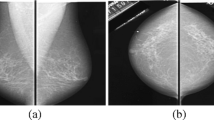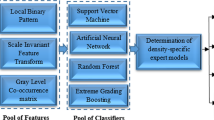Abstract
Breast cancer is becoming a leading death of women all over the world; clinical experiments demonstrate that early detection and accurate diagnosis can increase the potential of treatment. In order to improve the breast cancer diagnosis precision, this paper presents a novel automated segmentation and classification method for mammograms. We conduct the experiment on both DDSM database and MIAS database, firstly extract the region of interests (ROIs) with chain codes and using the rough set (RS) method to enhance the ROIs, secondly segment the mass region from the location ROIs with an improved vector field convolution (VFC) snake and following extract features from the mass region and its surroundings, and then establish features database with 32 dimensions; finally, these features are used as input to several classification techniques. In our work, the random forest is used and compared with support vector machine (SVM), genetic algorithm support vector machine (GA-SVM), particle swarm optimization support vector machine (PSO-SVM), and decision tree. The effectiveness of our method is evaluated by a comprehensive and objective evaluation system; also, Matthew’s correlation coefficient (MCC) indicator is used. Among the state-of-the-art classifiers, our method achieves the best performance with best accuracy of 97.73 %, and the MCC value reaches 0.8668 and 0.8652 in unique DDSM database and both two databases, respectively. Experimental results prove that the proposed method outperforms the other methods; it could consider applying in CAD systems to assist the physicians for breast cancer diagnosis.






Similar content being viewed by others
References
Jemal A, et al: Global cancer statistics. CA: Cancer J Clin 61(2):69–90, 2011
Siegel R, Naishadham D, Jemal A: Cancer statistics, 2013. CA: Cancer J Clin 63(1):11–30, 2013
Dubey R, Hanmandlu M, Gupta S: A comparison of two methods for the segmentation of masses in the digital mammograms. Comput Med Imaging Graph 34(3):185–191, 2010
Oliver A, et al: A review of automatic mass detection and segmentation in mammographic images. Med Image Anal 14(2):87–110, 2010
Cheng H, et al: Automated breast cancer detection and classification using ultrasound images: A survey. Pattern Recogn 43(1):299–317, 2010
Wu W-J, Lin S-W, Moon WK: Combining support vector machine with genetic algorithm to classify ultrasound breast tumor images. Comput Med Imaging Graph 36(8):627–633, 2012
Lu X, Ma Y, Xie W, et al: Automatic Mass Segmentation Method in mammograms based on improved VFC Snake model. in The 2014 International Conference on Image Processing, Computer Vision, and Pattern Recognition. 2014
Ma Y, Xie W, Wang Z, et al: A level set method for biomedical Image segmentation. in The 2013 International Conference on Image Processing, Computer Vision, and Pattern Recognition. 2013
Mazurowski MA, et al: Mutual information-based template matching scheme for detection of breast masses: From mammography to digital breast tomosynthesis. J Biomed Inform 44(5):815–823, 2011
Nascimento MZD, et al: Classification of masses in mammographic image using wavelet domain features and polynomial classifier. Expert Syst Appl 40(15):6213–6221, 2013
Delogu P, et al: Characterization of mammographic masses using a gradient-based segmentation algorithm and a neural classifier. Comput Biol Med 37(10):1479–1491, 2007
Moayedi F, et al: Contourlet-based mammography mass classification using the SVM family. Comput Biol Med 40(4):373–383, 2010
Wu W.-J., S.-W. Lin, and W.K. Moon: An Artificial Immune System-Based Support Vector Machine Approach for Classifying Ultrasound Breast Tumor Images. J Digit Imaging: p. 1–10, 2014
Cheng H, et al: Approaches for automated detection and classification of masses in mammograms. Pattern Recogn 39(4):646–668, 2006
Dong M, Ma Y: Breast cancer diagnosis development research based on morphological characteristics parameters of breast tumor cells. Chin J Clin 7(11):5023–5026, 2013
Issac Niwas S, et al: Analysis of nuclei textures of fine needle aspirated cytology images for breast cancer diagnosis using Complex Daubechies wavelets. Signal Process 93(10):2828–2837, 2013
Karakıs R, Tez M, Kılıc YA, et al: A genetic algorithm model based on artificial neural network for prediction of axillary lymph node status in breast cancer. Eng Appl Artif Intell 26(3):945–950, 2013
Lacson R, et al: Evaluation of an Automated Information Extraction Tool for Imaging Data Elements to Populate a Breast Cancer Screening Registry. J Digit Imaging: p. 1–9, 2014
Bowyer K, et al: The digital database for screening mammography. in Third International Workshop on Digital Mammography. 1996.
Suckling J, et al: The mammographic image analysis society digital mammogram database. 1994
Starren J, Johnson S.M: Expressiveness of the Breast Imaging Reporting and Database System (BI-RADS). in Proceedings of the AMIA Annual Fall Symposium. : American Medical Informatics Association, 1997
Pawlak Z: Rough set approach to knowledge-based decision support. Eur J Oper Res 99(1):48–57, 1997
Kass M, Witkin A, Terzopoulos D: Snakes: Active contour models. Int J Comput Vis 1(4):321–331, 1988
Li B, Acton ST: Active contour external force using vector field convolution for image segmentation. IEEE Trans Image Process 16(8):2096–2106, 2007
Xu X: Research on detection of breast mass in mammography. Huazhong University of Science and Technology, 2010.
Li, L., et al., False-positive reduction in CAD mass detection using a competitive classification strategy. Medical Physics 28(2):250–258, 2001
Petrick N, et al: Automated detection of breast masses on mammograms using adaptive contrast enhancement and texture classification. Med Phys 23(10):1685–1696, 1996
Catarious Jr, DM: A.H. Baydush, and C.E. Floyd Jr, Characterization of difference of Gaussian filters in the detection of mammographic regions. Med Phys 33(11):4104–4114, 2006
Petrick N, et al: Combined adaptive enhancement and region-growing segmentation of breast masses on digitized mammograms. Med Phys 26(8):1642–1654, 1999
Zheng B, et al: A method to improve visual similarity of breast masses for an interactive computer-aided diagnosis environment. Med Phys 33(1):111–117, 2006
Christoyianni I, Dermatas E, Kokkinakis G: Fast detection of masses in computer-aided mammography. IEEE Signal Proc Mag 17(1):54–64, 2000
Ma Y, Gu X, Wang Y: Histogram similarity measure using variable bin size distance. Comput Vis Image Underst 114(8):981–989, 2010
Melgani F, Bazi Y: Classification of electrocardiogram signals with support vector machines and particle swarm optimization. IEEE Trans Inf Technol Biomed 12(5):667–677, 2008
Breiman L: Random forests. Mach Learn 45(1):5–32, 2001
Friedl MA, Brodley CE: Decision tree classification of land cover from remotely sensed data. Remote Sens Environ 61(3):399–409, 1997
Valdimir V. and N. Vapnik: The nature of statistical learning theory. 1995, Springer
Vapnik VN, Vapnik V: Statistical learning theory, vol. 2. Wiley, New York, 1998
Zhang T: An introduction to support vector machines and other kernel-based learning methods. AI Mag 22(2):103, 2001
Braga-Neto UM, Dougherty ER: Is cross-validation valid for small-sample microarray classification? Bioinformatics 20(3):374–380, 2004
Author information
Authors and Affiliations
Corresponding author
Rights and permissions
About this article
Cite this article
Dong, M., Lu, X., Ma, Y. et al. An Efficient Approach for Automated Mass Segmentation and Classification in Mammograms. J Digit Imaging 28, 613–625 (2015). https://doi.org/10.1007/s10278-015-9778-4
Published:
Issue Date:
DOI: https://doi.org/10.1007/s10278-015-9778-4




